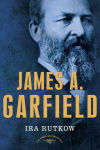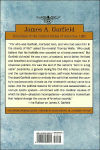Read an Excerpt
James A. Garfield
By Ira Rutkow Times Books
ISBN: 0-805-06950-X
Chapter One
Saturday, July 2, 1881, was as pleasant a day as can come with an American summer weekend. For James Abram Garfield, the twentieth president of the United States, the exquisite weather heightened his anticipation of an enjoyable train ride to Williamstown, Massachusetts. He planned to attend the commencement of his alma mater, Williams College, and then, with his wife, Lucretia, take an extended trip through New England. For the forty-nine-year-old Garfield, it had been a stressful four months since his inauguration; he was in the midst of a bitter fight between the warring Stalwart and Half-Breed factions of his Republican Party over political patronage. The new president looked forward to a relaxing getaway.
Garfield had been awake since early morning and, after some horseplay with his sons, awaited the arrival of James G. Blaine, his secretary of state. Eighteen years had passed since their simultaneous swearings in as United States congressmen, and, although their relationship had been stormy at times, they were now close friends. Garfield wanted one more opportunity to talk politics, especially about his growing disfavor for Vice President Chester A. Arthur, who had taken positions in opposition to him on some of the more contentious issues before Congress. Blaine accompanied Garfield on the five-minute carriage ride to the Baltimore and Potomac train depot. Despite the assassination of Abraham Lincolnsixteen years earlier, the American president still had no personal bodyguards. Newspaper editors thought nothing of publicly posting his daily schedule, including details such as the location and time of departure for meetings and even vacations.
At 9:20 A.M., Garfield and Blaine, walking side by side, entered the station's ladies' waiting room - men were also allowed in the area. Several individuals milled about, including a slightly built, shabbily dressed man who paced up and down rather nervously. As the president and secretary of state passed through the room, the odd-looking stranger spotted them and suddenly whirled toward the two men. Positioning himself six feet behind and to the right of Garfield, the man drew an ivory-handled revolver from his pocket, leveled it at the president, and fired twice. The first shot caused a slight flesh wound of the right arm but the second entered the middle of the right side of Garfield's back, jolting him forward. The president's legs broke from under him as he slumped to the wooden floor. Blaine, with a terrified look, cried out, "My God, he has been murdered! What is the meaning of this?" Turning toward the shooter, he recognized him as Charles J. Guiteau, a persistent job seeker, who for months had pestered State Department and White House officials regarding patronage positions. Guiteau attempted to flee the scene but was apprehended by a policeman. As the assassin was dragged away, he told the officer, "I did it and will go to jail for it. I am a Stalwart and Arthur will be president."
Onlookers gathered around the fallen president as messengers were dispatched to look for any available physician. Within five minutes, a health officer for the District of Columbia arrived. He found Garfield stuporous, with large beads of perspiration upon his brow. As a method of stimulation - and in keeping with contemporary medical practice - the doctor had Garfield swallow a mixture of brandy and aromatic ammonia spirit. With Garfield more alert, he was turned on his side and his coat lifted to reveal the wound with its slight hemorrhage. Garfield inquired about the injury and, when told it was not serious, shook his head and said, "Doctor, I am a dead man." He asked to be taken back to the White House. As the horse-drawn ambulance clattered over the rough cobblestones of Sixth Street, the injured Garfield was jostled to and fro. A surging crowd struggled to keep up with the fast-moving wagon. Brought to the family room at the White House, Garfield received round-the-clock medical care, but despite extraordinary efforts his end came in a tortuous and controversial death seventy-nine days later, on September 19.
James A. Garfield soon disappeared from the public's memory, and he remains one of America's least remembered chief executives. "For who was Garfield, martyred man, and who had seen him in the streets of life?" asked the novelist Thomas Wolfe. "Who could believe that his footfalls ever sounded on a lonely pavement?" But Garfield did exist - he was a son, a husband, and a father. He lived and breathed and laughed and cried and played a major role in American politics. He was the last of the nation's "born in a log cabin" presidents, a general during the Civil War, and the quintessential rags-to-riches, self-made American man. Even in death, Garfield came to embody the strive-and-succeed spirit that marked the country's socioeconomic climate as the nineteenth century came to a close. The clinical reasons for why he died - physician incompetence mixed with an all-consuming medical hubris - provided a momentum within the medical profession that helped change the course of American health care.
Garfield was president during the Gilded Age, so named by Mark Twain in an 1873 utopian satire. Twain's title was not a laudatory label but a triple play on words. There was the gilt of the upper class's overindulgences, the guilt brought on by the financial shenanigans of Wall Street tycoons and robber barons, and the guilds that represented special interest groups, labor unions, political bosses, and even the manufacturing monopolies. The country paid more attention to the outsize personalities of industrialists such as Andrew Carnegie, Henry Clay Frick, Jay Gould, J. P. Morgan, and John D. Rockefeller than to the activities of career politicians who could not be differentiated by actions or appearances. Indeed, the federal government had moved away from the extensive national attention that it had received through the Civil War and the early years of Reconstruction.
Although the so-called lost presidents of the Gilded Age (Rutherford B. Hayes, James A. Garfield, Chester A. Arthur, Grover Cleveland, and Benjamin Harrison) are embedded only in our historical unconscious, they were an essential element in the tapestry of American life. These men might not have had starring roles in the eyes of the public, but their actions had consequences that affected the lives of millions of Americans. For this reason alone, a recounting of the career of James A. Garfield, the "young-man-in-a-hurry," the "political animal," the short-lived president of the United States, is fitting.
(Continues...)
Excerpted from James A. Garfield by Ira Rutkow Excerpted by permission.
All rights reserved. No part of this excerpt may be reproduced or reprinted without permission in writing from the publisher.
Excerpts are provided by Dial-A-Book Inc. solely for the personal use of visitors to this web site.






